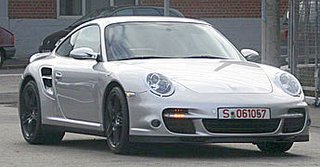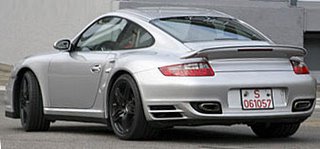Uncloaked! 2006 911 Turbo: Porsche's silver bullet spied on shakedown test
Spies have undermined Porsche's plan to keep its seventh-generation 911 Turbo secret until its world premiere at the Geneva motor show next February.
Building on the wide-bodied appearance of the recently introduced 4S, the 997-series Turbo declares itself with a unique front bumper carrying high-intensity LED indicators and parking lights integrated into a horizontal bar running across the outer air ducts. The fog lamps are set low on the corners within special housings designed to protect them from stone damage.
Along the flanks, sills under the doors are more pronounced and sizeable air ducts ahead of the rear wheel arches provide efficient cooling. Changes to the rear include the adoption of a reshaped biplane wing assembly that Porsche says will provide added levels of downforce, and a bumper with small ducts to pull hot air out of the engine bay. Completing the makeover, lightweight 19-inch alloy wheels wear ultra-low-profile tires, accentuating a significantly lower ride height than standard 911 models.
 Power outputs of up to 500 hp-a massive 80-hp or 19 percent increase above the outgoing model's 420 hp. The company's habit of incremental improvement suggests the figure could be significantly lower, though with others advertising 500 hp, Porsche must be tempted to respond. Nothing is official just yet, but we're told to expect a subtle 30-hp gain, taking the new model up to 450 hp (the same power obtainable by adding a Porsche X50 power kit to today's 911 Turbo S-perhaps a similar option will be offer-ed on the new model).
Power outputs of up to 500 hp-a massive 80-hp or 19 percent increase above the outgoing model's 420 hp. The company's habit of incremental improvement suggests the figure could be significantly lower, though with others advertising 500 hp, Porsche must be tempted to respond. Nothing is official just yet, but we're told to expect a subtle 30-hp gain, taking the new model up to 450 hp (the same power obtainable by adding a Porsche X50 power kit to today's 911 Turbo S-perhaps a similar option will be offer-ed on the new model).The Turbo's torque figure also rises by about 30 lb-ft to 457 lb-ft. Drive goes to all four wheels via a standard six-speed manual unit or a new double-clutch automatic gearbox, and Porsche's familiar full-time awd system.
 Key to the increased output is Variable Turbine Geometry technology for the two turbo-chargers. Common on high-performance diesel engines, VTG continuously adjusts the angle of the turbocharger's vanes to provide a more linear delivery of power and wider spread of torque. To make this work on gasoline engines, with much higher exhaust temperatures than diesel units, the BorgWarner-developed turbos employ heat-resistant ceramics. The engine also benefits from improved variable intake and exhaust valve timing.
Key to the increased output is Variable Turbine Geometry technology for the two turbo-chargers. Common on high-performance diesel engines, VTG continuously adjusts the angle of the turbocharger's vanes to provide a more linear delivery of power and wider spread of torque. To make this work on gasoline engines, with much higher exhaust temperatures than diesel units, the BorgWarner-developed turbos employ heat-resistant ceramics. The engine also benefits from improved variable intake and exhaust valve timing.The 997 Turbo's weight is up to about 3520 pounds. Even with the added weight, the 997 Turbo gains in power-to-weight ratio and should be able to hit 60 mph in well under 4.0 seconds with a top speed of 190 mph
© autoweek.com





0 Comments:
Post a Comment
<< Home